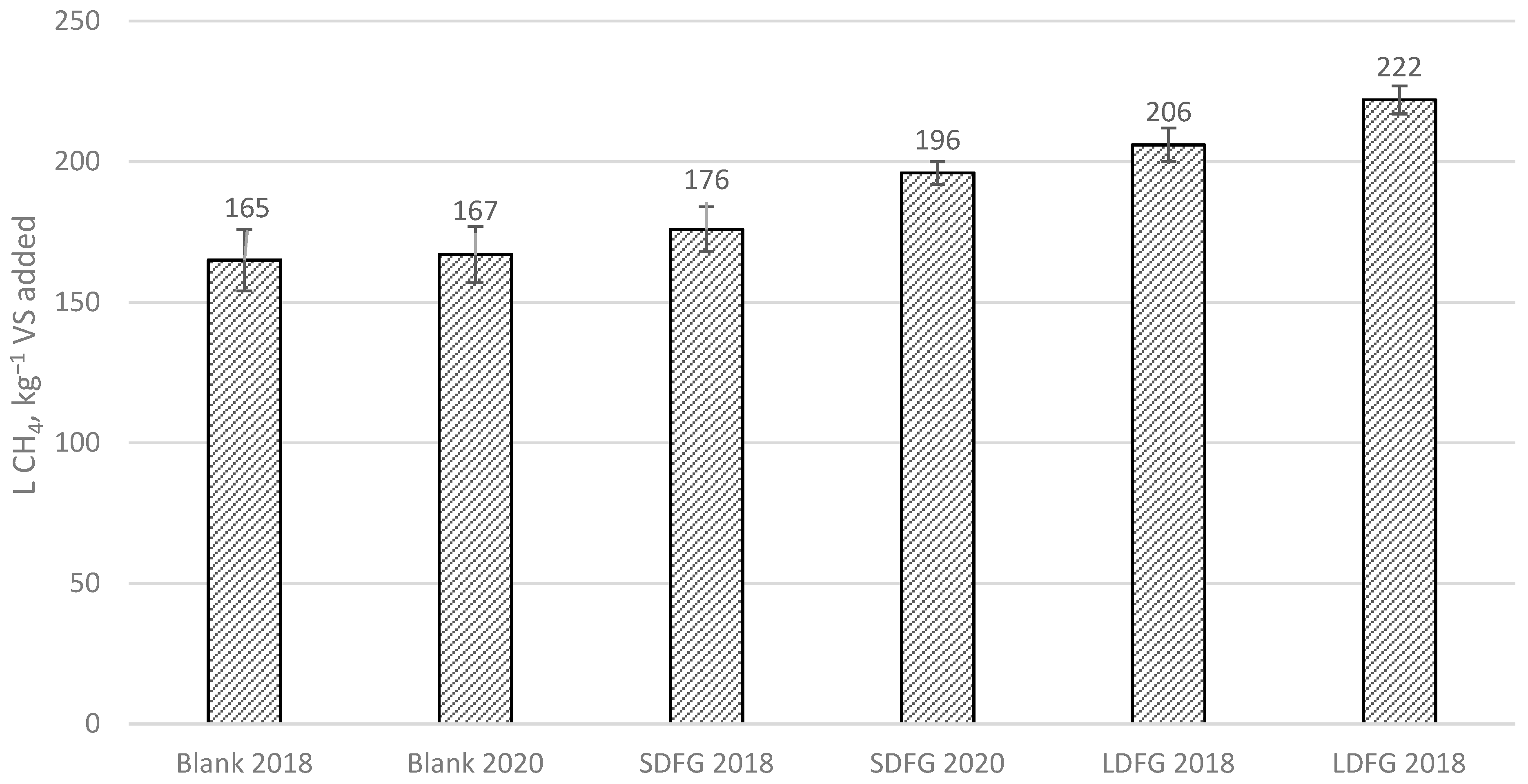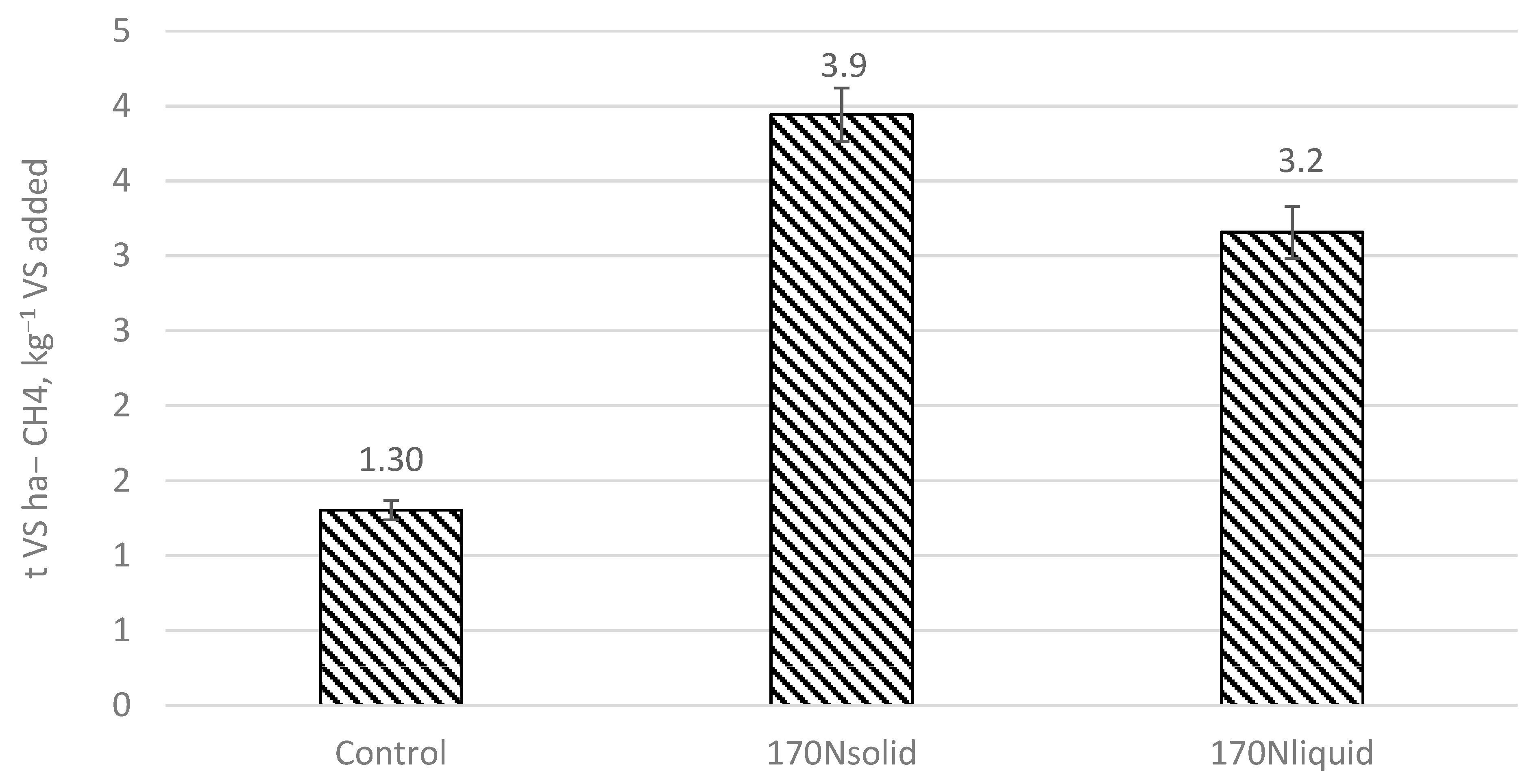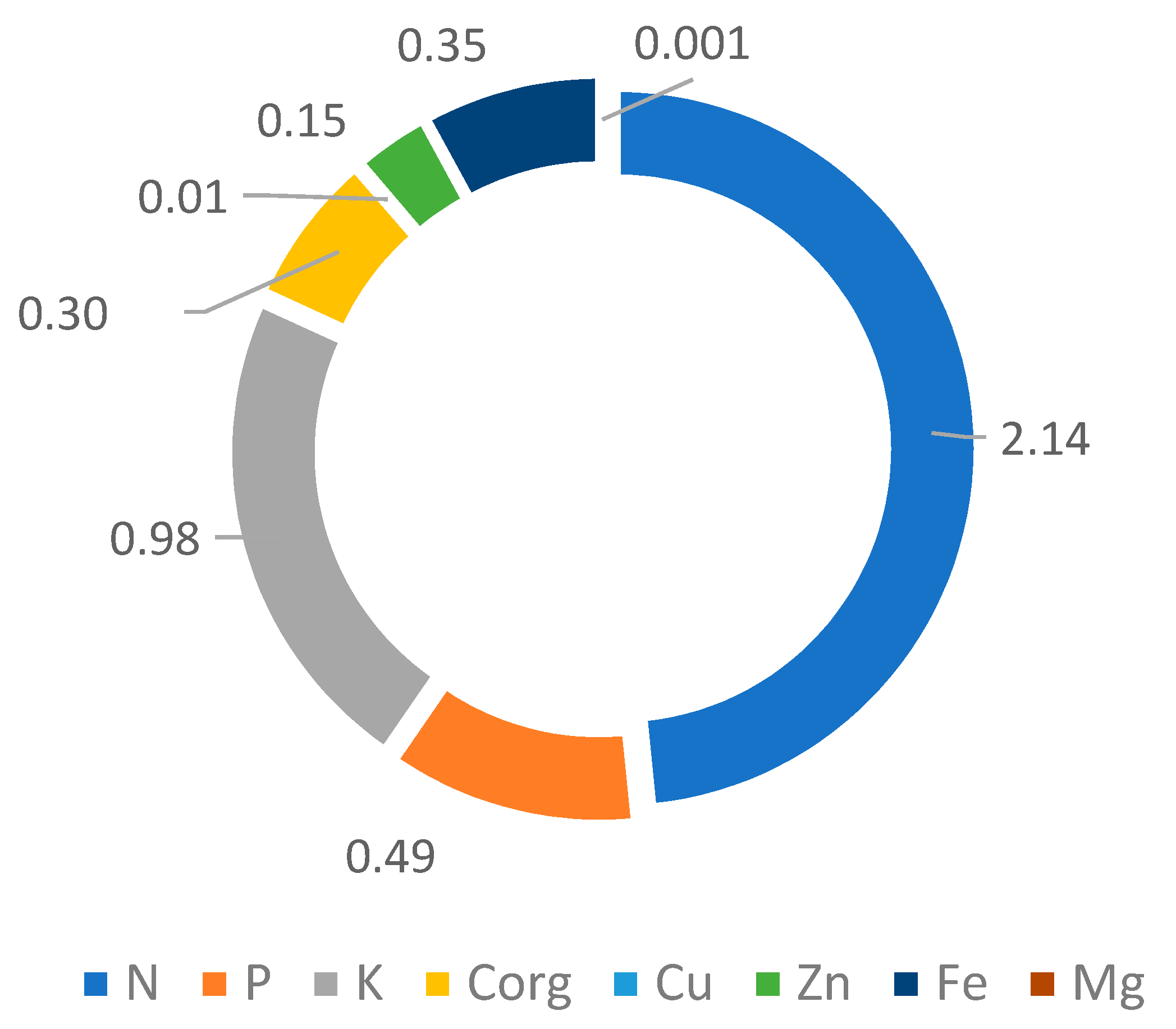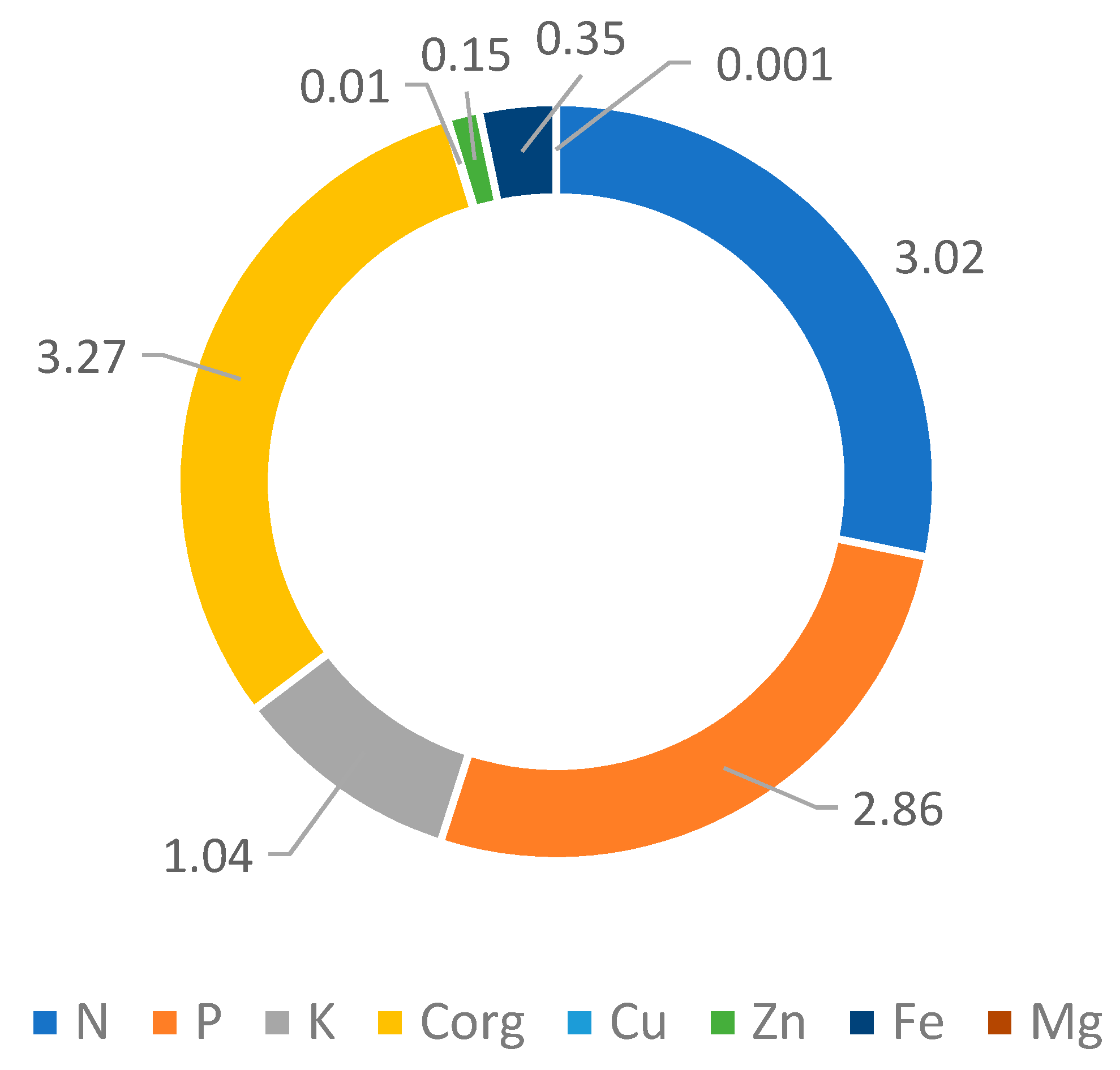Towards a Full Circular Economy in Biogas Plants: Sustainable Management of Digestate for Growing Biomass Feedstocks and Use as Biofertilizer
Abstract
:1. Introduction
2. Materials and Methods
2.1. Digestate Sampling and Description of Selected Biogas Plants
2.2. Digestate Fertilization Field Experimental Area and Field Operations
2.3. Methodology for Estimating Digestate Value
2.4. Biomethane Potential Assessment
2.5. Analytical Methods for Digestate Analysis
2.6. Field Experiment and Biomass Sampling
3. Results and Discussion
3.1. Characteristics of the Analyzed Biogas Plants
3.2. Characteristics of Analyzed Digestate
3.3. Biogas Potential Results
3.4. Digestate Value
4. Conclusions
Author Contributions
Funding
Institutional Review Board Statement
Informed Consent Statement
Data Availability Statement
Acknowledgments
Conflicts of Interest
References
- Gustafsson, M.; Anderberg, S. Dimensions and characteristics of biogas policies—Modelling the European policy landscape. Renew. Sustain. Energy Rev. 2021, 135. [Google Scholar] [CrossRef]
- European Biogas Association. EBA Annual Report 2020. Available online: https://www.europeanbiogas.eu/eba-statistical-report-2020/ (accessed on 12 April 2021).
- Kampman, B.; Leguijt, C.; Scholten, T.; Tallat-Kelpsaite, J.; Brückmann, R.; Maroulis, G.; Lesschen, J.P.; Meesters, K.; Sikirica, N.; Elbersen, B. Optimal Use of Biogas from Waste Streams: An Assessment of the Potential of Biogas from Digestion in the EU beyond 2020. European Commission 2017. Available online: https://edepot.wur.nl/416128 (accessed on 14 April 2021).
- IRENA. Renewable Power Generation Costs in 2019; International Renewable Energy Agency: Abu Dhabi, United Arab Emirates, 2020. [Google Scholar]
- Provenzano, M.R.; Cavallo, O.; Malerba, A.D.; Fabbri, C.; Zaccone, C. Unravelling (maize silage) digestate features throughout a full-scale plant: A spectroscopic and thermal approach. J. Clean. Prod. 2018, 193, 372–378. [Google Scholar] [CrossRef]
- Horváth, I.S.; Tabatabaei, M.; Karimi, K.; Kumar, R. Recent updates on biogas production—A review. Biofuel Res. J. 2016, 3, 394–402. [Google Scholar] [CrossRef] [Green Version]
- Seruga, P.; Krzywonos, M.; Paluszak, Z.; Urbanowska, A.; Pawlak-Kruczek, H.; Niedźwiecki, Ł.; Pińkowska, H. Pathogen reduction potential in anaerobic digestion of organic fraction of municipal solid waste and food waste. Molecules 2020, 25, 275. [Google Scholar] [CrossRef] [PubMed] [Green Version]
- Debosz, K.; Petersen, S.O.; Kure, L.K.; Ambus, P. Evaluating effects of sewage sludge and household compost on soil physical, chemical and microbiological properties. Appl. Soil Ecol. 2002, 19, 237–248. [Google Scholar] [CrossRef]
- Barampouti, E.M.; Mai, S.; Malamis, D.; Moustakas, K.; Loizidou, M. Exploring technological alternatives of nutrient recovery from digestate as a secondary resource. Renew. Sustain. Energy Rev. 2020, 134. [Google Scholar] [CrossRef]
- EU Nitrates Directive (91/676/EEC). Available online: https://eur-lex.europa.eu/legal-content/EN/TXT/?uri=CELEX:01991L0676-20081211 (accessed on 27 April 2021).
- Nabel, M.; Temperton, V.M.; Poorter, H.; Lücke, A.; Jablonowski, N.D. Energizing marginal soils—The establishment of the energy crop Sida hermaphrodita as dependent on digestate fertilization, NPK, and legume intercropping. Biomass Bioenergy 2016, 87, 9–16. [Google Scholar] [CrossRef] [Green Version]
- Herrmann, A.; Sieling, K.; Wienforth, B.; Taube, F.; Kage, H. Short-term effects of biogas residue application on yield performance and N balance parameters of maize in different cropping systems. J. Agric. Sci. 2013, 151, 449–462. [Google Scholar] [CrossRef]
- Czekala, W.; Wojcieszak, D.; Lewicki, A.; Janczak, D.; Waliszewska, H.; Smurzynska, A. Nutrient Value of Digestate from Agricultural Biogas Plant in Poland. In Proceedings of the 2018 2nd International Conference on Green Energy and Applications (ICGEA), Singapore, 24–26 March 2018. [Google Scholar] [CrossRef]
- Vázquez-Rowe, I.; Golkowska, K.; Lebuf, V.; Vaneeckhaute, C.; Michels, E.; Meers, E.; Benetto, E.; Koster, D. Environmental assessment of digestate treatment technologies using LCA methodology. Waste Manag. 2015, 43, 442–459. [Google Scholar] [CrossRef]
- Peng, W.; Pivato, A. Sustainable Management of Digestate from the Organic Fraction of Municipal Solid Waste and Food Waste Under the Concepts of Back to Earth Alternatives and Circular Economy. Waste Biomass Valorization 2017, 10, 465–481. [Google Scholar] [CrossRef]
- Czekała, W.; Lewicki, A.; Pochwatka, P.; Czekała, A.; Wojcieszak, D.; Jóźwiakowski, K.; Waliszewska, H. Digestate management in Polish farms as an element of the nutrient cycle. J. Clean. Prod. 2020, 242. [Google Scholar] [CrossRef]
- Slepetiene, A.; Volungevicius, J.; Jurgutis, L.; Liaudanskiene, I.; Amaleviciute-Volunge, K.; Slepetys, J.; Ceseviciene, J. The potential of digestate as a biofertilizer in eroded soils of Lithuania. Waste Manag. 2020, 102, 441–451. [Google Scholar] [CrossRef]
- Jurgutis, L.; Slepetiene, A.; Amaleviciute-Volunge, K.; Volungevicius, J.; Slepetys, J. The effect of digestate fertilisation on grass biogas yield and soil properties in field-biomass-biogas-field renewable energy production approach in Lithuania. Biomass Bioenergy 2021. JBAB-D-20-01473R1, in review. [Google Scholar]
- Nikitin, B.A. A method for soil humus determination. Agric. Chem. 1999, 3, 156–158. (In Russian) [Google Scholar]
- Uludag-Demirer, S.; Demirer, G.N. Post-anaerobic treatability and residual biogas potential of digestate. Biomass Convers. Biorefinery 2021. [Google Scholar] [CrossRef]
- Ellacuriaga, M.; García-Cascallana, J.; Gómez, X. Biogas Production from Organic Wastes: Integrating Concepts of Circular Economy. Fuels 2021, 2, 144–167. [Google Scholar] [CrossRef]
- Adebayo, A.O.; Jekayinfa, S.O.; Ahmed, N.A.; Ogunkunle, O. Effect of organic loading rate on biogas yields of pig slurry in a continuously stirred tank reactor at mesophilic temperature. Procedia Manuf. 2019, 35, 337–342. [Google Scholar] [CrossRef]
- Moset, V.; Cerisuelo, A.; Sutaryo, S.; Møller, H.B. Process performance of anaerobic co-digestion of raw and acidified pig slurry. Water Res. 2012, 46, 5019–5027. [Google Scholar] [CrossRef]
- Rodríguez-Abalde, Á.; Flotats, X.; Fernández, B. Optimization of the anaerobic co-digestion of pasteurized slaughterhouse waste, pig slurry and glycerine. Waste Manag. 2017, 61, 521–528. [Google Scholar] [CrossRef] [Green Version]
- Zhang, W.; Lang, Q.; Pan, Z.; Jiang, Y.; Liebetrau, J.; Nelles, M.; Dong, H.; Dong, R. Performance evaluation of a novel anaerobic digestion operation process for treating high-solids content chicken manure: Effect of reduction of the hydraulic retention time at a constant organic loading rate. Waste Manag. 2017, 64, 340–347. [Google Scholar] [CrossRef]
- Ennouri, H.; Miladi, B.; Diaz, Z.S.; Güelfo, L.A.F.; Solera, R.; Hamdi, M.; Bouallagui, H. Effect of thermal pretreatment on the biogas production and microbial communities balance during anaerobic digestion of urban and industrial waste activated sludge. Bioresour. Technol. 2016, 214, 184–191. [Google Scholar] [CrossRef]
- Provenzano, M.R.; Iannuzzi, G.; Fabbri, C.; Senesi, N. Qualitative characterization and differentiation of digestates from different biowastes using FTIR and fluorescence spectroscopies. J. Environ. Prot. 2011, 2, 83–89. [Google Scholar] [CrossRef] [Green Version]
- Odlare, M.; Arthurson, V.; Pell, M.; Svensson, K.; Nehrenheim, E.; Abubaker, J. Land application of organic waste—effects on the soil ecosystem. Appl. Energy 2011, 88, 2210–2218. [Google Scholar] [CrossRef]
- Brienza, C.; Sigurnjak, I.; Meier, T.; Michels, E.; Adani, F.; Schoumans, O.; Vaneeckhaute, C.; Meers, E. Techno-economic assessment at full scale of a biogas refinery plant receiving nitrogen rich feedstock and producing renewable energy and biobased fertilisers. J. Clean. Prod. 2021, 308. [Google Scholar] [CrossRef]
- Fuchs, W.; Wang, X.; Gabauer, W.; Ortner, M.; Li, Z. 2018. Tackling ammonia inhibition for efficient biogas production from chicken manure: Status and technical trends in Europe and China. Renew. Sustain. Energy Rev. 2018, 97, 186–199. [Google Scholar] [CrossRef]
- Bareha, Y.; Girault, R.; Guezel, S.; Chaker, J.; Trémier, A. Modeling the fate of organic nitrogen during anaerobic digestion: Development of a bioaccessibility based ADM1. Water Res. 2019, 154, 298–315. [Google Scholar] [CrossRef]
- Wang, M.; Zheng, Q.; Shen, Q.; Guo, S. The critical role of potassium in plant stress response. Int. J. Mol. Sci. 2013, 14, 7370–7390. [Google Scholar] [CrossRef] [Green Version]
- Bader, B.R.; Taban, S.K.; Fahmi, A.H.; Abood, M.A.; Hamdi, G.J. Potassium availability in soil amended with organic matter and phosphorous fertiliser under water stress during maize (Zea mays L.) growth. J. Saudi Soc. Agric. Sci. [CrossRef]
- Tariq, A.; Pan, K.; Olatunji, O.A. Phosphorous fertilization alleviates drought effects on Alnus cremastogyne by regulating its antioxidant and osmotic potential. Sci. Rep. 2018, 8, 5644. [Google Scholar] [CrossRef]
- Marisa, C.; Almeida, R.; Dror, I.; Garuti, M.; Grabarczyk, M.; Guillon, E.; Hullebusch, E.D.; Laera, A.; Mikac, N.; Muňoz, J.; et al. Assessing fate and bioavailability of trace elements in soils after digestate application. Trace Elem. Anaerob. Biotechnol. 2019, 153. [Google Scholar] [CrossRef]
- Alloway, B.J. Zinc in Soils and Crop Nutrition, 2nd ed.; IZA and IFA Brussels: Paris, France, 2008. [Google Scholar]
- Tilvikiene, V.; Venslauskas, K.; Povilaitis, V.; Navickas, K.; Zuperka, V.; Kadziuliene, Z. The effect of digestate and mineral fertilisation of cocksfoot grass on greenhouse gas emissions in a cocksfoot-based biogas production system. Energy Sustain. Soc. 2020, 10, 13. [Google Scholar] [CrossRef]
- Lee, M.-S.; Urgun-Demirtas, M.; Shen, Y.; Zumpf, C.; Anderson, K.E.; Rayburn, L.A.; Lee, D.K. Effect of digestate and digestate supplemented with biochar on switchgrass growth and chemical composition. Biomass Bioenergy 2021, 144. [Google Scholar] [CrossRef]




| Parameter | Description | Unit |
|---|---|---|
| PrED | Price of ingredient in digestate | EUR kg−1 |
| PrEM | Pure ingredient price in the alternative fertilizer | EUR kg−1 |
| CEM | Concentration of ingredient in alternative fertilizer | kgingredient ·kgfertilizer−1 |
| CED | Concentration of ingredient in the digestate | kgingredient ·kgbiofertilizer−1 |
| VD | Value of digestate with regard to N, P, K, OC, Cu, Zn, Fe, Mg content | EUR kg−1 |
| PrED-N | Value of digestate with regard to N content | EUR kg−1 |
| PrED-P | Value of digestate with regard to P content | EUR kg−1 |
| PrED-K | Value of digestate with regard to K content | EUR kg−1 |
| PrED-Ca | Value of digestate with regard to Ca content | EUR kg−1 |
| PrED-OC | Value of digestate with regard to OC content | EUR kg−1 |
| PrED-Cu | Value of digestate with regard to Cu content | EUR kg−1 |
| PrED-Zn | Value of digestate with regard to Zn content | EUR kg−1 |
| PrED-Fe | Value of digestate with regard to Fe content | EUR kg−1 |
| PrED-Mg | Value of digestate with regard to Mg content | EUR kg−1 |
| Feedstock Used, % of Total Volume | BP 1 | BP 2 | BP 3 | BP 4 | BP 5 | BP 6 | BP 7 | BP 8 |
|---|---|---|---|---|---|---|---|---|
| Pig slurry | 75 | 48 | 60 | 54 | 70 | 70 | 52 | 49 |
| Beetroot pulp | 14 | 26 | 10 | 12 | 0 | 0 | 6 | 0 |
| Grain mill bran | 3 | 5 | 4 | 3 | 0 | 0 | 3 | 2 |
| Starch production waste | 8 | 0 | 0 | 21 | 30 | 30 | 14 | 0 |
| Discarded vegetables | 0 | 13 | 14 | 0 | 0 | 0 | 3 | 3 |
| Whey | 0 | 8 | 12 | 10 | 0 | 0 | 0 | 0 |
| Chicken manure | 0 | 0 | 0 | 0 | 0 | 0 | 23 | 0 |
| Thermally pretreated waste | 0 | 0 | 0 | 0 | 0 | 0 | 0 | 45 |
| Parameter | BP 1 | BP 2 | BP 3 | BP 4 | BP 5 | BP 6 | BP 7 | BP 8 | |
|---|---|---|---|---|---|---|---|---|---|
| Produced power capacity | kW | 1043 | 994 | 1032 | 1027 | 977 | 985 | 1008 | 1010 |
| Biogas production | m3 d−1 | 11,920 | 11,355 | 11,795 | 11,740 | 11,164 | 11,260 | 11,525 | 11,545 |
| Total solids (TSs) of feedstock mix | % | 10.3 | 15.4 | 10.4 | 12.3 | 9.8 | 9.8 | 15.7 | 11.8 |
| Temperature | °C | 39 | 41 | 42 | 42 | 41 | 41 | 38 | 36 |
| HRT | d | 31 | 32 | 32 | 31 | 35 | 40 | 42 | 44 |
| OLR | kg VS m−3 d−1 | 2.55 | 2.76 | 2.90 | 2.67 | 2.45 | 2.77 | 2.10 | 2.05 |
| LFD | m3 | 72,610 | 31,122 | 51,058 | 53,239 | 79,706 | 79,706 | 34,493 | 38,129 |
| SFD | t | 27,840 | 21,836 | 19,667 | 26,028 | 28,261 | 28,261 | 24,957 | 17,562 |
| Feedstock price | kEUR | 363 | 359 | 278 | 393 | 197 | 194 | 350 | 65 |
| Liquid Digestate | ||||||||||
|---|---|---|---|---|---|---|---|---|---|---|
| Parameter | Unit | BP 1 | BP 2 | BP 3 | BP 4 | BP 5 | BP 6 | BP 7 | BP 8 | Average (BP 1–BP 8) |
| TS | % FM | 2.18 | 3.99 | 2.46 | 2.38 | 2.09 | 3.49 | 4.58 | 4.31 | 3.18 |
| VS | % FM | 1.80 | 2.92 | 2.25 | 2.22 | 1.75 | 2.45 | 3.51 | 3.46 | 2.55 |
| pH | 7.53 | 7.97 | 7.92 | 7.96 | 8.18 | 7.82 | 7.86 | 7.63 | 7.86 | |
| TKN | % FM | 0.26 | 0.32 | 0.25 | 0.29 | 0.27 | 0.38 | 0.45 | 0.73 | 0.37 |
| P | % FM | 0.07 | 0.05 | 0.05 | 0.04 | 0.04 | 0.08 | 0.05 | 0.08 | 0.06 |
| K | % FM | 0.13 | 0.20 | 0.25 | 0.16 | 0.21 | 0.33 | 0.17 | 0.13 | 0.20 |
| OC | % FM | 0.84 | 1.17 | 1.08 | 0.72 | 0.72 | 1.17 | 1.70 | 2.63 | 1.25 |
| Ca | % FM | 0.52 | 0.46 | 0.30 | 0.14 | 0.12 | 0.12 | 0.40 | 0.22 | 0.28 |
| Mg | % FM | 0.04 | 0.08 | 0.03 | 0.03 | 0.04 | 0.05 | 0.04 | 0.06 | 0.05 |
| Zn | mg·kg−1 FM | 33.98 | 44.11 | 28.34 | 24.04 | 53.40 | 39.31 | 14.27 | 27.01 | 33.06 |
| Fe | mg·kg−1 FM | 82.48 | 126.64 | 72.35 | 88.64 | 142.11 | 131.08 | 77.34 | 137.51 | 107.3 |
| Cu | mg·kg−1 FM | 10.60 | 9.21 | 5.26 | 3.94 | 8.72 | 6.76 | 3.77 | 11.13 | 7.42 |
| Solid Digestate | ||||||||||
|---|---|---|---|---|---|---|---|---|---|---|
| Parameter | Unit | BP 1 | BP 2 | BP 3 | BP 4 | BP 5 | BP 6 | BP 7 | BP 8 | Average |
| TS | % FM | 28.91 | 29.80 | 23.92 | 33.63 | 27.95 | 26.73 | 29.44 | 25.08 | 28.18 |
| VS | % FM | 24.42 | 23.12 | 18.34 | 27.45 | 23.15 | 21.97 | 25.26 | 20.30 | 23.00 |
| pH | 8.43 | 8.66 | 8.32 | 8.46 | 8.67 | 8.47 | 8.37 | 8.39 | 8.47 | |
| TKN | % FM | 0.45 | 0.60 | 0.42 | 0.58 | 0.49 | 0.52 | 0.65 | 0.44 | 0.52 |
| P | % FM | 0.30 | 0.39 | 0.42 | 0.40 | 0.35 | 0.26 | 0.21 | 0.31 | 0.33 |
| K | % FM | 0.15 | 0.23 | 0.26 | 0.16 | 0.19 | 0.33 | 0.19 | 0.14 | 0.21 |
| OC | % FM | 14.21 | 15.14 | 11.55 | 15.86 | 13.71 | 14.02 | 14.79 | 9.81 | 13.64 |
| Ca | % FM | 0.42 | 1.15 | 0.60 | 1.18 | 0.47 | 0.48 | 0.44 | 0.27 | 0.63 |
| Mg | % FM | 0.14 | 0.27 | 0.21 | 0.19 | 0.21 | 0.24 | 0.12 | 0.09 | 0.18 |
| Zn | mg·kg−1 FM | 96.75 | 79.25 | 85.18 | 88.84 | 151.19 | 110.57 | 27.51 | 27.33 | 83.33 |
| Fe | mg·kg−1 FM | 411.23 | 481.28 | 416.22 | 523.45 | 709.83 | 623.02 | 280.66 | 224.51 | 458.8 |
| Cu | mg·kg−1 FM | 26.51 | 15.11 | 15.37 | 11.66 | 34.73 | 20.76 | 4.65 | 4.03 | 16.60 |
| Element | Price for 1 kg Component * | Liquid Digestate, EUR t−1 | Solid Digestate, EUR t−1 | ||||
|---|---|---|---|---|---|---|---|
| Average | Min | Max | Average | Min | Max | ||
| N | 0.58 | 2.14 | 1.46 | 4.22 | 3.02 | 2.45 | 3.75 |
| P | 0.87 | 0.49 | 0.30 | 0.69 | 2.86 | 1.81 | 3.68 |
| K | 0.50 | 0.98 | 0.64 | 1.64 | 1.04 | 0.70 | 1.66 |
| OC | 0.02 | 0.30 | 0.17 | 0.63 | 3.27 | 2.35 | 3.81 |
| Cu | 1.00 | 0.01 | 0.004 | 0.01 | 0.01 | 0.004 | 0.01 |
| Zn | 4.40 | 0.15 | 0.06 | 0.23 | 0.15 | 0.06 | 0.23 |
| Fe | 3.26 | 0.35 | 0.24 | 0.46 | 0.35 | 0.24 | 0.46 |
| Mg | 12.40 | 0.001 | 0.001 | 0.001 | 0.001 | 0.001 | 0.001 |
| Total value | 4.42 | 2.88 | 7.89 | 10.70 | 7.62 | 13.61 | |
Publisher’s Note: MDPI stays neutral with regard to jurisdictional claims in published maps and institutional affiliations. |
© 2021 by the authors. Licensee MDPI, Basel, Switzerland. This article is an open access article distributed under the terms and conditions of the Creative Commons Attribution (CC BY) license (https://creativecommons.org/licenses/by/4.0/).
Share and Cite
Jurgutis, L.; Šlepetienė, A.; Šlepetys, J.; Cesevičienė, J. Towards a Full Circular Economy in Biogas Plants: Sustainable Management of Digestate for Growing Biomass Feedstocks and Use as Biofertilizer. Energies 2021, 14, 4272. https://doi.org/10.3390/en14144272
Jurgutis L, Šlepetienė A, Šlepetys J, Cesevičienė J. Towards a Full Circular Economy in Biogas Plants: Sustainable Management of Digestate for Growing Biomass Feedstocks and Use as Biofertilizer. Energies. 2021; 14(14):4272. https://doi.org/10.3390/en14144272
Chicago/Turabian StyleJurgutis, Linas, Alvyra Šlepetienė, Jonas Šlepetys, and Jurgita Cesevičienė. 2021. "Towards a Full Circular Economy in Biogas Plants: Sustainable Management of Digestate for Growing Biomass Feedstocks and Use as Biofertilizer" Energies 14, no. 14: 4272. https://doi.org/10.3390/en14144272
APA StyleJurgutis, L., Šlepetienė, A., Šlepetys, J., & Cesevičienė, J. (2021). Towards a Full Circular Economy in Biogas Plants: Sustainable Management of Digestate for Growing Biomass Feedstocks and Use as Biofertilizer. Energies, 14(14), 4272. https://doi.org/10.3390/en14144272








